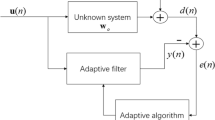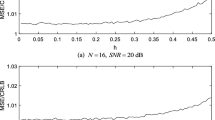Abstract
The theoretical analysis and simulation of the performance of a matched filter code acquisition structure with a median filter as the aiding device to cancel CW jamming in the AWGN channel is described. Both coherent and noncoherent structures are considered. As performance measures, the probability of detection and of a false alarm and mean acquisition times are used. Two kinds of analysis for coherent acquisition structure are presented. At first, the approximation for the pdf of the input signal to the comparator is used. Next, the probabilities are calculated directly. This is called the direct form. For the analysis of noncoherent acquisition, the pdf approximation of the coherent case is used. The performance of the median filter structure is compared to the performance of a simple linear interference cancellation method. The effect of CW jamming can be eliminated by both methods. Fixed thresholds of the comparator and the constant false alarm probability (CFAR) criteria are used. It is concluded that the median filter has a better performance, especially when fixed thresholds are used.
Similar content being viewed by others
References
R.E. Ziemer and R.L. Peterson, Digital Communications and Spread Spectrum Systems, MacMillan Publishing Company, New York, p. 750, 1985.
M. Pandit, “Mean Acquisition Time of Active and Passive Correlation Acquisition Systems for Spread-Spectrum Communication Systems”, IEE Proc., Vol. 128, Pt. F, No. 4, pp. 211–214, 1981.
A. Polydoros and C.L. Weber, “A Unified Approach to Serial Search Spread-Spectrum Code Acquisition - Part II: A Matched-Filter Receiver”, IEEE Tran. on Comm., Vol. COM-32, No.5, pp. 211–214, 1984.
Y. T. Su, “Rapid Code Acquisition Algorithms Employing PN Matched Filters”, IEEE Tran. on Comm., Vol. 36, No.6, pp. 724–733, 1988.
E.W. Siess and C.L. Weber, “Acquisition of Direct Sequence Signals with Modulation and Jamming”, IEEE Journal on Selected Areas in Comm., Vol. SAC-4, No.2, pp. 254–272, 1986.
L.B. Milstein, “Interference Suppression to Aid Acquisition in Direct-Sequence Spread-Spectrum Communications”, IEEE Trans. on Comm., Vol. 36, No.11, pp. 1200–1207, 1988.
J. Iinatti and P. Leppänen, “Performance of DS Receiver Code Acquisition Using Matched Filters and median Filters in Continuous Tone Jamming”, in Proc. of the Third Inter. Symposium on Personal, Indoor and Mobile Radio Comm. (PIMRC'92), Boston, MA, USA, pp. 460–464, October 19- 21, 1992.
Iinatti J. and Leppänen P., “On the Mean Acquisition Times of DS Receiver Code Synchronization Using Matched Filter and Median Filters in AWGN Channel and Continuous/Pulsed Tone Jamming”, in Proc. of IEEE Military Comm. Conference (MILCOM'93), Boston, MA, USA, Vol. 3, pp. 779–783, October 11- 14, 1993.
J. Iinatti and P. Leppänen, “Attempt of Using Median Filter as an Aiding Device of Noncoherent Matched Filter Code Acquisition of DS Receiver in Continuous Tone jamming”, in Proc. of the Third Inter. Symposium on Spread Spectrum Techniques and Appl. (ISSSTA'94), Oulu, Finland, Vol. 2, pp. 603–607, July 4- 6, 1994.
L.-M. Li and L.B. Milstein, “Rejection of Narrow-Band Interference in PN Spread-Spectrum Systems Using Transversal Filters”, IEEE Trans. on Comm., Vol. COM-30, No.5, pp. 925-928, 1982.
J. Iinatti, “Performance Comparison of DS Signal Matched Filter Acquisition Using Median Filter and Transversal Filter as an Aiding Device in AWGN Channel and CW Jamming”, in Proc. of IEEE Military Comm. Conference (MILCOM'95), San Diego, CA, USA, Vol. 3, pp. 1181–1185, November 5- 8, 1995.
P. Heinonen and Y. Neuvo, “FIR-Median Hybrid Filters”, IEEE Trans. on Acoustic, Speech, and Signal Processing, Vol. ASSP-35, No.6, pp. 832–838, 1987.
J. Proakis, Digital Communications, McGrawHill Book Company, pp. 905, 1989.
T. Arnheiter, Simulation of Noncoherent MF + MeF Code Acquisition Structure, Studienarbeit, University of Oulu, Telecommunication Laboratory, Oulu, Finland, pp. 42, 1995.
F. Schäfer, Simulation of Noncoherent MF + TrF Code Acquisition Structure, Studienarbeit, University of Oulu, Telecommunication Laboratory, Oulu, Finland, pp. 47, 1995.
M. Darnell, “New HF Data Transmission Techniques”, J.K. Skwirzynski, Sitjoff and Noordhoff (eds.), Comm. Systems and Random Process Theory, pp. 912–915, 1978.
Author information
Authors and Affiliations
Rights and permissions
About this article
Cite this article
Iinatti, J., Leppänen, P. Performance Analysis of DS Signal Code Acquisition Using the Matched Filter and the Median Filter. Wireless Personal Communications 8, 93–111 (1998). https://doi.org/10.1023/A:1008899008580
Issue Date:
DOI: https://doi.org/10.1023/A:1008899008580




